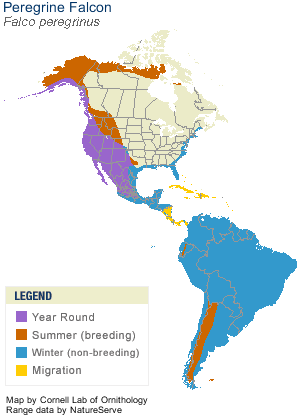
Winged Messenger Nations: Birds in American Indian Oral Tradition
Falcon: Chayton
Fast Facts
Brian Ferry March 2012
Common Name: Peregrine Falcon
Scientific Name: Falco Peregrinus
Native Name: Chayton
Characteristics from Oral Tradition: messenger

Media
Links
U.S. Fish & Wildlife Endangered Species (2014)
http://www.fws.gov/endangered/what-we-do/peregrine-falcon.html

Image from http://www.biologicaldiversity.org/
Ornithologists recognize as many as 19 subspecies of Peregrine Falcon. In addition to “peregrine” (“wandering”) falcon, English speaking peoples have call it duck hawk, bullet hawk, game hawk, great-footed hawk or Peale’s Falcon. Internationally, names are associations include the Maltese Falcon, Barbary Falcon and the Black Shaheen. Considering its fantastic range of habitat, including all environments and continents with the exception of the poles and New Zealand, there are undoubtedly dozen of lesser known indigenous monikers.
Archeological evidence demonstrates that raptors and the peregrine falcon in particular, have been a significant part of the indigenous cultures of North America. Native Americans at least 1200 years before present who contemporary western archeologists label as “Mississippians,” used the peregrine, along with other several birds of prey, in imagery as a likely symbol of divinity and buried individuals in clothing associated with this distinctive raptor.
Linguistic knowledge of the languages of North America, though presently limited, finds that the peregrine has been specifically identified by various Native peoples, especially in regions presently identified as prime habitat. For example, to Salish speaking peoples of the Northwest, the peregrine or duck hawk is called aátat. From native oral traditions, indigenous falcons are distinguished from other birds such as the stories of “eagle and the prairie falcon” of the Yokut of California or tales of the “falcon and the duck” of the Blackfeet of Montana.
Here in the northern plains, the Siouan language groups, specifically Lakota, have a broader term for falcon cetan (chay-tahn). Reverend Eugene Buechel of the Red Cloud Indian School on the Pine Ridge Indian Reservation in South Dakota conducted extensive linguistic research and produced the Lakota –English Dictionary, first published in 1970. The dictionary appears to more greatly distinguish the raptor in the following sub-classification of the term: “Ceta watap’ela zi, The evening grossbeak, They call it that way because the bird goes much after other birds, but it is not a shrike.” Additional research such as sought in this proposal could likely serve to clarify the linguistic distinctions between raptors.